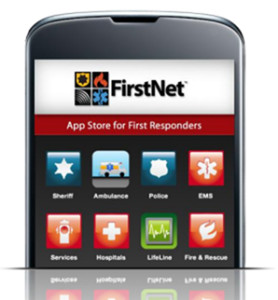UPDATE: FirstNet Implications For Building OwnersPosted on September 28, 2016. As the First Responder Network Authority (FirstNet) gears up to award a contract to one lucky bidder to build the first-ever nationwide public safety broadband network, many are curious about the FirstNet implications for building owners and how this project may ultimately affect them. PHOTO COURTESY: New York State Division of Homeland Security and Emergency Services (NYS DHSES, psbb.ny.gov) The FirstNet initiative, which is led by the federal government, does not spell out any direct requirements for building owners, and typically building regulations are established by local jurisdictions. However, from the outset, FirstNet has made it clear that companies seeking a contract would be evaluated on whether they offered a reasonable amount of network coverage, including in-building coverage. Public safety personnel today are restricted in their use of location-based data services indoors because of limited in-building coverage. Whoever wins the FirstNet contract – we can expect an announcement at the beginning of November – should “maximize in-building coverage as well as the amount of the area and population covered that meets or exceeds the in-building link budget,” as the request for proposal stated. At least three entities submitted proposals. Lingering uncertainties about the ambitious project have prompted concern regarding FirstNet implications for building owners, along with concern that national guidelines might eventually find their way into local mandates. “We’re not really sure how this will play out. The question is, would there be a cost associated with retrofitting existing systems?” said Mike Driscoll, senior wireless consultant at the Irvine Co. in Irvine, Calif. “This could affect us from a little to a lot. It’s going to depend on what they’re going to require.” Location-Based Tech To Be Among FirstNet Implications For Building OwnersWhile top-down mandates on building owners are not in the works in Washington, FirstNet officials are working with the Safer Buildings Coalition to address in-building coverage. “Our engagement with the coalition includes working on governance, technical and operational issues for in-building data coverage for the future,” said Ryan Oremland, a FirstNet spokesman. The Public Safety Communications Research (PSCR) program, a FirstNet partner, is also working on in-building coverage issues. Last May, the PSCR published a Location-based Services R&D Roadmap Report, which noted several ways that location-enabled technologies could benefit public safety personnel inside buildings and pointed out barriers to realizing those benefits. *Note: The PSCR program is a joint effort between the Communications Technology Laboratory at the National Institute of Standards and Technology (NIST) and the Institute for Telecommunication Sciences at the National Telecommunications and Information Administration (NTIA). Both NIST and NTIA are part of the Department of Commerce, and the PSCR program is housed at the department’s labs in Boulder, Colo.
The ability of devices – such as handsets, tablets, badges or other wearable items – to track objects or personnel and transmit environmental conditions indoors would also improve first responders’ situational awareness. However, the existing Global Positioning System and the broader Global Navigation Satellite System do not meet public safety requirements for indoor location accuracy. A more diversified approach to improving indoor accuracy is needed, according to the PSCR report, and there are several gaps to close before that happens. Buildings are being made with more resilient materials, making it more difficult for GPS signals to penetrate structures, and retrofitting all buildings with indoor cellular capabilities is cost-prohibitive and is one of the potential FirstNet implications for building owners that may pose difficulty. Carriers may not have sufficient bandwidth to deploy high-accuracy positioning capabilities. Terrestrial beacon systems (TBS) could be used to supplement cellular capabilities, the report notes, but device vendors need to establish the capabilities to support multiple TBS constellations in a single device. The PSCR report’s authors acknowledge that it will be some years before location-based services become highly useful to public safety personnel indoors, but, like the FirstNet initiative itself, the forecast for this technology is ambitious. Within five to 10 years, according to the report, high-resolution elevation data – i.e., data that determines which floor of a multi-story building someone is on – will become more widely available, and in the 10- to 20-year timeframe, location-based services are expected to be available in all environments. By Caron Carlson – Safer Buildings Coalition Contributor Learn more about joining the SBC by clicking here. Also be sure follow us on our Facebook page, Twitter (@SaferBuildings), and connect with us on LinkedIn. |


 More precise indoor location tracking and routing would give police and firefighters a better view of individuals inside buildings, improving their situational awareness, but as the PSCR report points out, there are numerous hurdles to overcome first: Bandwidth requirements for indoor 3D routing are undefined; a wider availability of digital floor plans for buildings is needed; manual and automated data collection for digitizing floor plans require a lot of resources; software for indoor route planning is “an underserved” capability; and the accuracy of indoor location and z-axis – i.e., vertical – measurements is not good in today’s networks.
More precise indoor location tracking and routing would give police and firefighters a better view of individuals inside buildings, improving their situational awareness, but as the PSCR report points out, there are numerous hurdles to overcome first: Bandwidth requirements for indoor 3D routing are undefined; a wider availability of digital floor plans for buildings is needed; manual and automated data collection for digitizing floor plans require a lot of resources; software for indoor route planning is “an underserved” capability; and the accuracy of indoor location and z-axis – i.e., vertical – measurements is not good in today’s networks.